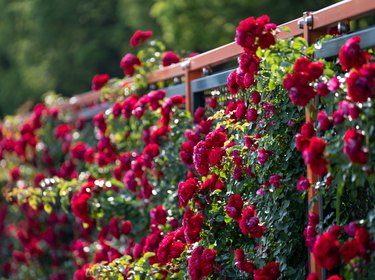
Like a kid in a candy store — that's a gardener in a nursery. Oh yes, we all know the feeling: that love at first sight, the swoon, the color ... the fragrance! Many of us have come home with plants that don't really fit or won't do well in our yard. But if you're choosing plants for a garden room design, your search will likely be more focused because you'll be looking for plants with vertical potential.
To design your yard into separate areas, or rooms, you need, well, separators. These can be quick and dirty, like trellises with climbing vines or beds with tall annuals. But in the long run, you'll want to add more permanent and structural solutions because these will provide depth and resonance to your garden design.
Video of the Day
Video of the Day
Let's explore plants that can provide quick cover in the first year or two and then those types of plantings that lend themselves to creating natural and long-living screens, walls, doorways, paths, and other elements that make up the backbone of a garden landscape with multiple rooms. But first, consider your site's requirements and possible limitations.
Identify Your Site's Requirements
Let's assume that you are far enough along in your garden design or makeover that you know the location of the garden rooms you're developing. Now, you can identify some key factors in plant choice: available light, available space, and soil type.
For example, if your site tends toward clay, it won't do any good to choose plants that thrive only in more sandy or granular soils. Similarly, sun-loving plants situated in a shady spot will not produce the blooms you want and will likely begin to look spindly. And when considering space, think about existing plants or structures that might influence the type of plant you choose, whether it's because they cast shade or the resulting area is too small for very large plants.
Take this information with you as you peruse the nursery's offerings and the suggestions here.
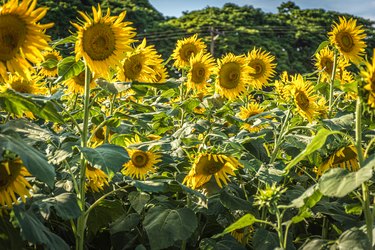
Plant Climbers and Fast Growers for Quick Cover
I don't know any gardener who is not in a hurry. We all want our Sunset magazine look now — or even yesterday. But any new garden landscape takes time, of course. To ease the impatience, let's take some steps that will make the waiting a little easier.
Create some quick room dividers using climbing vines, fast-growing shrubs, tall annuals, and some perennials that grow quickly.
Climbing Vines
There are so many climbing vines out there that choosing some for your garden rooms will be tough. Here are a few recommendations.
Perennial Climbing Vines
- Hops (Humulus lupulus L.): We grow Willamette hops since we live in the Willamette Valley in
Oregon, and this is hops country. But hops are pretty versatile and can
grow in many climes. While hops are used in beer making, they are also lovely vines in their own right.
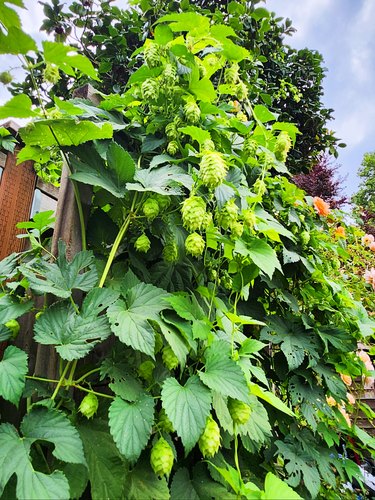
- Star jasmine (Trachelospermum jasminoides): Ubiquitous among prized climbers, the tiny white flower clusters of this evergreen vine have a marvelous scent.

- Clematis (Clematis spp.): Of course, clematis is on this list, and it is a genus comprised of about 380 species, so you could spend weeks choosing clematis varieties. Clematis won't cover your arbor in its first year, but depending on the species and environmental influences, it just might the next year and then every year after that.
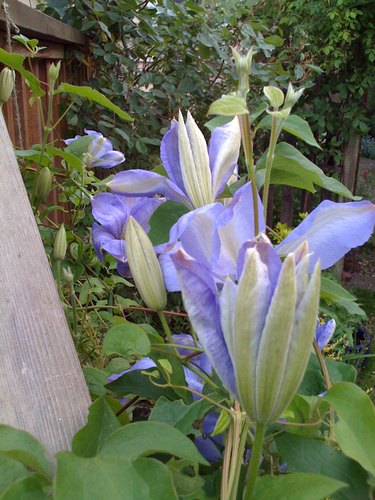
- Trumpet vine (Campsis radicans): This one can be invasive, so be careful. We planted a trumpet vine to climb onto our deck handrails and then we transplanted it some years later. Well, guess what? It's still climbing up the handrails. But it's so gorgeous that we let it be.
Annual Climbing Vines
- Black-eyed Susan vines (Thunbergia alata): These plants offer sweet yellow flowers with black centers on a vine. Generally, the flowers are a paler yellow than the common black-eyed Susan flower.

- Scarlet runner beans (Phaseolus coccineus): These plants have red attractive flowers that will turn into edible beans that are really only tasty enough to eat until they are 2 to 3 inches long.
- Morning glories (Ipomoea purpurea): A traditional cottage garden flower recognizable by its trumpet-shaped flowers that open only in the morning, this vine can produce blooms in a range of colors, including deep blue, purple, pink, and white. Watch out, though
— in some areas, they may be considered invasive.
- Nasturtium (Tropaeolum majus): Maybe this entry should have been under "edibles" because these flowers are indeed edible, but usually, this plant is considered ornamental. It can climb to 10 feet, with flowers that range from yellow to salmon, orange, and red. While it's an annual, it easily reseeds to appear the following summer.
Climbing Roses
Roses are ... well, there are no adjectives to appropriately describe this empress of the garden. Many climbing roses are very fast growers and can blanket a trellis in a season. The more mature the rose plant, however, the faster and more full its growth each year.
Consider not only size (some are stated to reach only 5 feet high, while some can climb 20 feet or more) but also blooming period. I always go for the "continual" or "repeat" bloomers because why not?
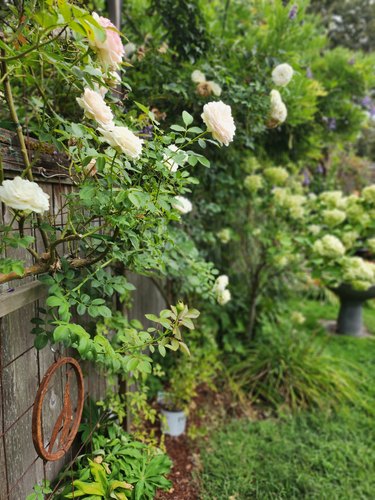
Edible Vining Plants
Vining plants that are attractive and fast-growing enough to cover a trellis during the summer months are not limited to ornamentals. Three vines that come to mind are grapes, cucumbers, and beans.
Grapevines — just, wow. We planted two vines on a single trellis in 2010 and then cut one down after two years because one is really enough. They not only fruit (assuming you do your homework and find table grapes that are suited for your area) but their vines are so vigorous that they just might knock over your trellis. So, if you do plant a grapevine (and I hope you do), be sure to build a sturdy arbor or other structure.

And the humble cucumber is a summer fruit that can easily climb 6 feet or more in summer, with charming, fuzzy leaves and tiny yellow flowers that, of course, become delectable salad additions.
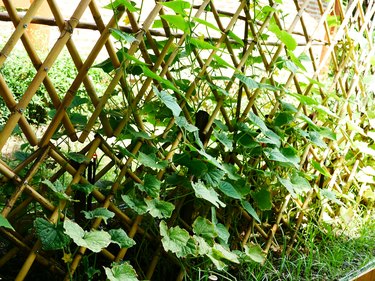
Green beans (or yellow, or red, or really any vining type) are also great for quick coverage.
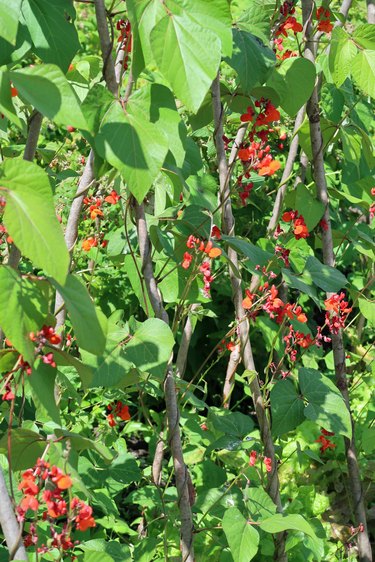
Tall Perennials and Annuals
You don't have to have hardscape like a wall, arbor, or trellis to separate garden rooms. Perhaps you are using a garden bed instead; in which case, fill it with vertical annuals and perennials.
Tall Perennials
Loads of perennials can reach 4 to 6 feet high easily enough to provide a decent wall between garden rooms. Here are a few of my favorites.
- Bee balm (Monarda didyma): These plants feature red, deep magenta, or pink showy blooms. My favorite is the deep red Jacob Cline. They grow up to 5 feet tall.

- Phlox (Phlox paniculata): Be sure to get the perennial version, sometimes also called "garden phlox" or even "tall phlox." While it comes in pinks and purples, the white variety shimmers with brilliance. It grows 4 to 5 feet tall.
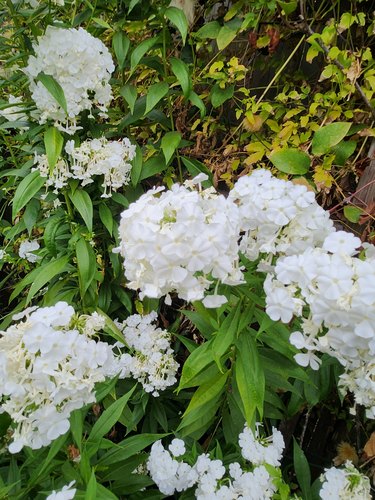
- Joe Pye weed (Eutrochium dubium): Maybe its name includes "weed" because it is such a vigorous grower, but its fluffy pink or purple blooms smell marvelous and attract pollinators like crazy.
- Goatsbeard (Astilbe biternata): Here's a 6-foot-tall knockout with feathery plumes of a creamy ivory. In very hot climes, it likes some afternoon shade.
Tall Annuals
Plenty of annuals can really put on some growth in a short time. Some grow tall but don't have the girth to help build a wall, but here are some that do.
- Amaranth (Amaranthus tricolor): These might also be called fountain plant or three-colored amaranth. It's a bushy plant that can reach 5 feet with showy flowers and leaves.
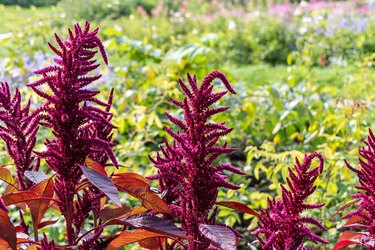
- Fountain grass (Cenchrus setaceus): No list of tall plants could avoid mentioning grasses, and this one has beautiful reddish bottlebrush-like flowers atop 4- to 5-foot stalks. Some varieties are considered invasive, so be sure to purchase this plant at a reputable nursery.
- Mexican sunflower (Tithonia rotundifolia): This marvelous annual species in the aster family quickly grows up to 6 feet. Its orange blooms are much loved by pollinators.
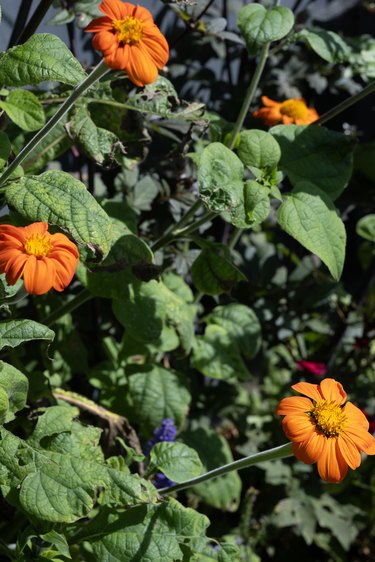
- Klondike Cosmos (Cosmos sulphureus): Also called orange cosmos or sulphur cosmos, this plant is a profuse bloomer and a fast grower, growing up to 6 feet tall.
Build the Backbone
It's a given that the backbone of a garden room design will include hardscape and not just plants. Elements like rock walls, pergolas, archways, pathways, and trellises are a must. But our focus today is on plants.
The primary living elements that create separation of space in a landscape are hedges; shrubs; espaliers; and columnar trees, such as Italian cypress.
Hedge Walls
These are a mainstay in any landscape, but they play a key role in a garden room design. Whether they are 4 feet tall or 8 feet (or taller), they define a garden room like no other plant. The great gardens of the world have traditionally made extensive use of hedging,
The foundational plants to create hedges are boxwood, yew, and hornbeam, sometimes pruned into fantastic shapes or topiary.

For home use, you'll probably want to stick with a simply pruned hedge. I do recommend planting these traditional species because over time, they will establish a depth of structure in your yard that faster-growing hedge plants cannot meet in style. We chose boxwood.
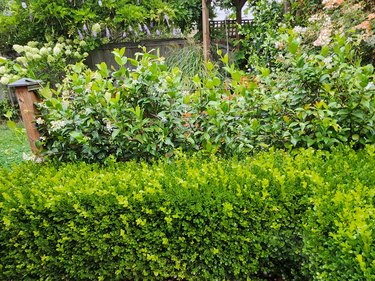
But if you are in a hurry, consider privet pruned into a hedge. For privet, there are multiple choices, many of which are considered invasive in multiple states, in particular Chinese privet (Ligustrum sinense). An outstanding variety, however, is Sunshine privet (Ligustrum sinense 'Sunshine'), which is a golden-leaved sterile cultivar that can reach 4 feet wide and 6 feet tall but can be pruned to any size.
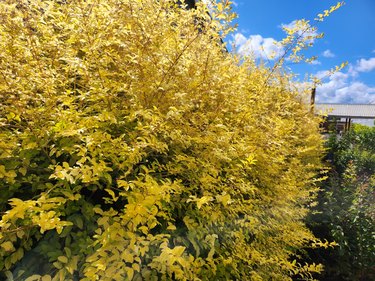
Let's Talk About Laurel
Laurel is very tempting as a solution when you want a quick hedge. But many laurel varieties when left to their own devices ... ouch. In particular, just say no to the common cherry laurel (Prunus laurocerasus), an aggressive plant that can put on 3 feet in width and height each year. If you don't prune this bad boy at least twice a year, it becomes a behemoth that swallows your garden whole. I have neighbors with this plant who pull out their 12-foot ladders every year and take their chances high in the air wielding a sharp object. No, thanks.
A laurel that plays nice (at least nicer) is the Portugal laurel (Prunus lusitanica), with more compact leaves and a slower growth rate.
Note that these laurels are not true laurels like the sweet bay laurel (Laurus nobilis), a slow-growing tree that would not help to create a fast hedge.

Espalier Walls
These are my favorite. While many people associate espaliers with fruit trees, in particular apples and pears, several woody shrubs can be trained to grow vertically on a trellis or support.
What is an espalier?
When I use the term "espalier," I do it quite loosely. Traditional espalier entails pruning a tree or shrub in a precise pattern, such as a cordon or a candelabra. That's too fussy and time-consuming for me, and it also requires the installation of exactly placed guide wires rather than the use of a simple trellis.
Instead, I'm referring to any plant or shrub that is trained vertically up or across a trellis so that it grows in a flat, 2D shape rather than in its natural shape. These are available at many nurseries (especially camellias), or you can just do it yourself, which is a lot cheaper.

Some plants that lend themselves to training on a trellis include camellias (especially the sasanqua species); pyracantha; and some woody hibiscus species, including rose of Sharon.
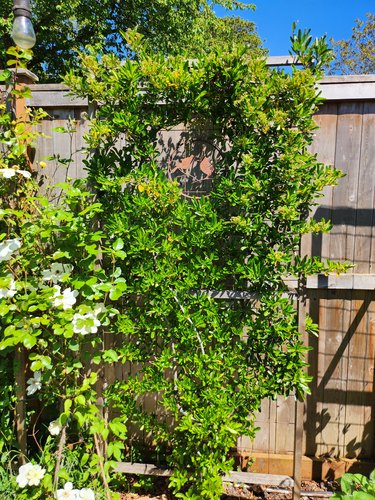
Columnar Tree Walls
Many trees grow or are trained in a columnar shape, perfect for creating a wall if you plant a few in a row. Among the most common are arborvitae (Thuja occidentalis), columnar-growing holly and juniper varieties, and Italian cypress. Any of these makes an awesome garden room divider, but we've all seen stands of arborvitae with one or more blighted trees, ruining the entire effect. This is the dread thuja blight fungus, which is very tough to get rid of.
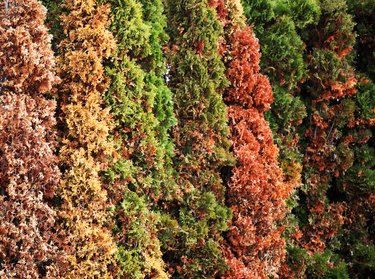
For this reason, I have never planted these trees and instead prefer Italian cypress or varieties of holly bred to grow in a columnar shape. These both do grow more slowly, however.

Finally, Create the Drama
Over time, your plants will take over and create a harmonious look that you could not have intentionally designed. You can help this harmony along by filling in the corners, adding drama, color, and texture. This is the fun part and where you just might head to a nursery and bring home something unexpected.
Traditional garden room design incorporates a cottage garden feel (a profusion of flowers). The most famous example of a garden room design infused with outrageous color and greenery is Sissinghurst Castle in Kent, U.K. Vita Sackville-West chose the flowers, while her husband Harold Nicolson designed the structure. Once the structure of various rooms was in place, Sackville-West filled it to the brim with texture, form, and color in the manner of what is called a "cottage garden."

If this frothy display is not to your liking, you may prefer a more sedate and peaceful theme of green with an emphasis on foliage, or as some of the great gardens in the world have done, focus on a specific color theme, like the White Garden at Sissinghurst.
But whatever your taste, this is when you fill in the gaps around your room walls, arbors, walkways, trellises, or patios. Choose shrubs that will complement your walls and add both perennials and annuals.
I'm partial to panicle hydrangeas (the cone-shaped flower rather than the round mophead), hostas, dahlias, camellias, and gardenias.
Happy planting!
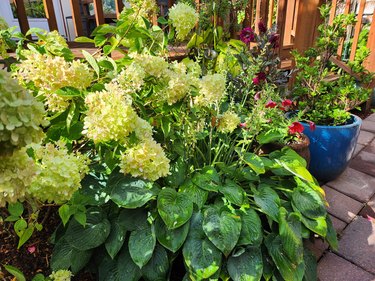
Don't Stop Here
Offered here are only a few possibilities for plants for your garden room landscape. We didn't talk about ornamental grasses, for instance, not to mention the plethora of shrubs with outstanding characteristics that can be used in multiple ways in the garden, such as viburnum, escalonia, lilac, many types of hibiscus, azaleas, and on and on.
I like to drive around and look at people's yards to get ideas in addition to going to nurseries. Sometimes, a neighbor's yard is a better place than a nursery
to see how a plant thrives in the local environment and how it is best used or situated. But whatever you do, have fun!